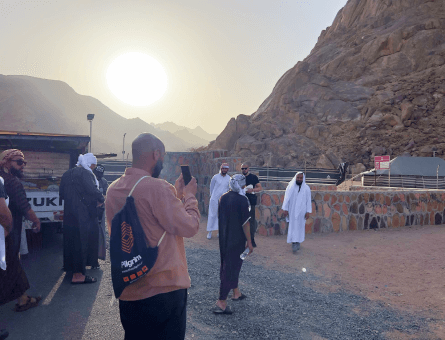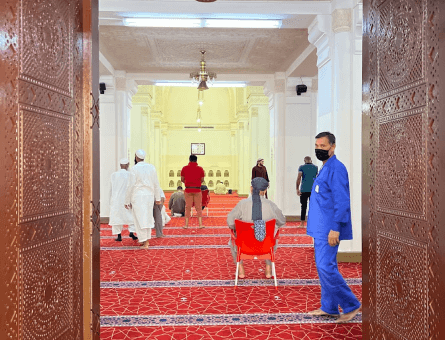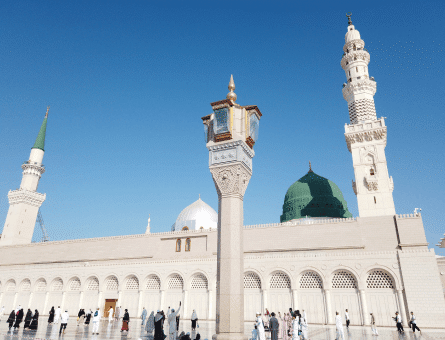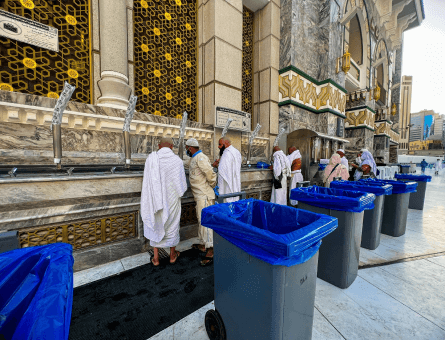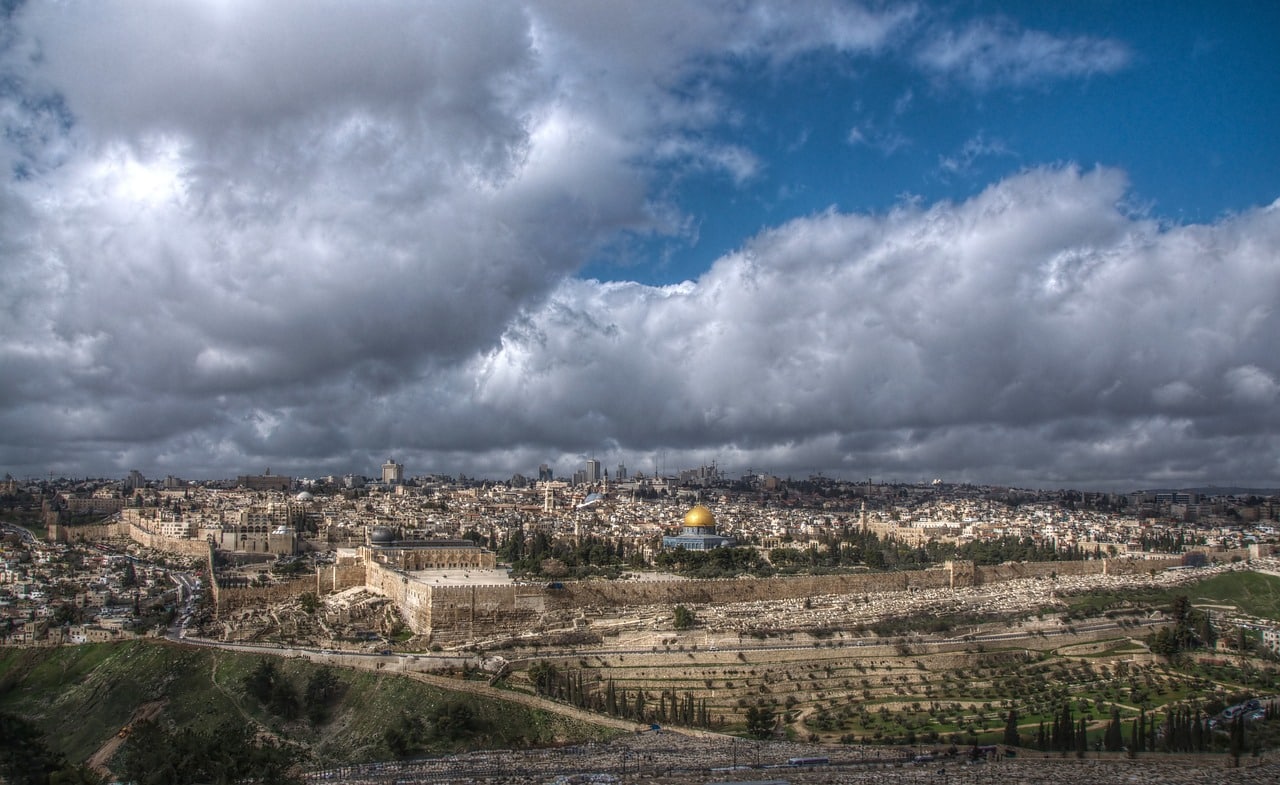Gates of Masjid Al Aqsa – Complete List Of 11 Babs/Doors
Masjid al-Aqsa, nestled in the heart of Jerusalem’s Old City, stands as a revered symbol of profound religious significance in Islam. Its iconic presence is not merely architectural; it encapsulates centuries of rich history, embodying the spiritual essence of the Muslim faith.
The Masjid Al Aqsa’s impressive gates, etched with cultural and religious narratives, serve as portals to previous Islamic eras.
Each gate, adorned with intricate designs, tells a tale of resilience and devotion, reflecting the diverse cultures and civilisations that have left their mark on this sacred space.
This hallowed sanctuary has witnessed the ebb and flow of time, standing resilient against the backdrop of historical events. Its significance is not confined to a single moment but extends across generations, fostering a deep sense of connection among the faithful.
Masjid al-Aqsa is a testament to the enduring spiritual legacy of Islam, beckoning believers from far and wide to partake in its sanctity and delve into the profound tapestry of religious and cultural history that it encapsulates.
As a beacon of faith and history, Masjid al-Aqsa continues to inspire awe and reverence, inviting all to explore the depths of its sacred embrace.
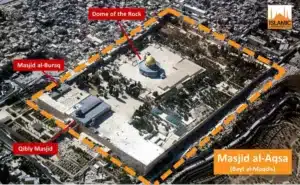
What Is Masjid Al Aqsa?
The Al-Aqsa Mosque, serves as the principal congregational mosque within the Al-Aqsa mosque in Jerusalem’s Old City. While occasionally referred to as al-Masjid al-Aqṣā, this name predominantly pertains to the entire area where it is located.
Why Is Masjid Al Aqsa So Special?
Nestled in the heart of Jerusalem’s Old City, the Al-Aqsa Mosque holds significant religious importance.
Muslims consider it the third holiest site after Mecca and Medina, with the Al-Aqsa compound hosting the Dome of the Rock, masjid Qibly and Masjid Al Buraq.
Constructed in the 8th century AD, it is believed, to be the place where Prophet Muhammad (PBUH) ascended to heaven for a night.
How Many Gates Are in Al Aqsa Mosque?
The mosque features 15 gates, with 10 open and five closed. Situated primarily on the wall to the west, the gate keys are held by the Islamic Waqf, but this does not include the Moroccan gate.
However, access is contingent upon permission from the police, who regulate site entry. We will explore the 10 open gates in this blog along with their historical significance.
What Does the Quran Say about Masjid Al Aqsa?
Masjid Al-Aqsa is mentioned a number of times in the Quran. One of those instances include the following verse 17:1 in the Al Isra chapter:
“Glory be to Him who carried His servant by night from Al Masjid Al Haram to Al Masjid Al Aqsa; the environs of which We have blessed, that We might show him some of Our signs. Indeed He is the Hearing, the Seeing.“

List of Gates of Masjid Al Aqsa
The Masjid al-Aqsa compound has 15 gates, with 10 currently open and five closed. Predominantly positioned along the wall that lies to the west, the Islamic Waqf holds all the keys except the one to the Moroccan gate.
However, the opening or closing of gates is subject to permission from the police, who regulate site entry. The open gates of Masjid Al Aqsa include:
- Bab al Asbat (The Tribe’s Gate)
- Bab al Hittah (The Gate of Remission)
- Bab al Atim (The Gate of Darkness)
- Bab Ghawanimah (Gate of Bani Ghanim)
- Bab An Nadhir (The Inspector’s Gate)
- Bab al Hadid (The Iron Gate)
- Bab al Qattanin (Cotton Merchant’s Gate)
- Bab al Matarah (The Ablution Gate)
- Bab as Salaam (Tranquillity Gate)
- Bab al Silsilah (Chain Gate)
- Bab al Magharibah (The morroccan gate)
Gate 1 – Bab al-Asbat (The Tribe’s Gate)
An esteemed ancient gate, Asbat Gate derives its name from early authorities, Ibn Al-Faqi, and Ibn Abdullahbi. Initially constructed by the Mamluk ruler Baibars, the doors underwent renovation during the Ottoman era.
According to legend, Sultan Suleiman I initiated the renovation of Jerusalem’s walls after an unsettling dream.
Situated towards the wall at the north of Haram Al Sharif, the Asbat Gate stands at the double gate and across the Awab Mihrab Mariam. The entrance is adorned with impressive decorations.
The surviving portion of the portal features a single opening with a semi-circular arch, characterised by a 45-degree chamfer and a segmented inner arch. The wall masonry, measuring 1.20 metres in length, hints at the existence of two gates.
Extending westward, the gate wall aligns with the early Islamic architecture and dimensions of Bab al-Hashmi, as noted by Ratrout.
Bab Al Asbat boasts a doorway width of 2.81 metres, a sill width inside the doorway measuring 3.30 metres, and an arch height of 4.30 metres. Positioned at ground level, this gate uniquely facilitates the entrance of ambulances into the mosque during emergencies.
Gate 2 – Bab al Hittah (The Gate of Remission)
Located on the north side of Masjid al-Aqsa, this gate (also known as Barclay Gate) stands as one of the oldest and serves as the chief entry point for visitors from the northerly side of al-Quds city.
Although its exact construction date is unknown, it underwent renovations during the Ayyubi and Ottoman periods. Adorned with hangers that were designed to hold lamps, this gate is the entry way for the Old City of Al-Quds.
Notably, the surviving gateway is characterised by a singular opening featuring a semi-circular arch with a distinct 45-degree chamfer and a segmental inner arch, a design element commonly observed in many gates of the enclave, particularly Bab al-Hashmi.
Gate 3 – Bab al-Atim (Sinai Gate)
Also known as the Sinai Gate or Gate of Darkness, Bab al-Atim is one of the gates within the Old City of Jerusalem. It is situated near Al-Aqsa Mosque. The gate holds historical and religious significance, and its name is derived from its proximity to the road leading to the Sinai Peninsula.
Like many gates in the Old City, it has unique features and plays a role in the access points to and from the historic city.
Known by various names, the most renowned being Bab al-Aa’tam due to the dark road from the north the gate is recognised as Bab al-Malik Faisal (King Faisal Gate) among Jerusalem residents, a name bestowed after a 1930 (or 1943 CE) visit and generous contribution by King Faisal of Iraq for its restoration.
Additional names include Bab al-Mu’azmiyya and Bab a-Dawadariya School Gate, linked to the al-Mu’azmiyya and the adjacent a-Dawadariya school.
Gate 4 – Bab Ghawanimah (Gate of Bani Ghanim)
Viewed from within the Temple Mount, this gate holds historical significance. This gate is on the small side compared to the rest of the gates.
Previously called the Hebron Gate, it now serves as an access point from the Muslim sector of the ancient city. Notably, the modern-day street level on this side of the Temple Mount is a bit higher in stature than the holy platform itself.
Following an unfortunate incident when the gate was set ablaze by a radical group, it was renovated. The southern wall is the retaining wall of the Temple Mount.
Gate 5 – Bab An Nadhir (The Inspector’s Gate)
This entrance underwent refurbishment during the reign of King Moathem Sharaf Ad Din. Featuring a substantial entrance height measuring 4.5m, its name came from the Inspector of Masjid al-Aqsa and the Ibrahimi Masjid, who lived near it. Previously identified as Michael’s Gate and the Prison Gate.
Gate 6 – Bab al Hadid (The Iron Gate)
This west side entrance, historically acknowledged as Aragun’s Gate, acquired this designation from its renovator, Prince Aragun Al Kamili, who simultaneously served as the founding father of the prestigious Araguniyah School.
Gate 7 – Bab al Qattanin (Cotton Merchant’s Gate)
Constructed by the sultan Muhammad bin Qaloun, the cotton merchant’s gate gate stands on the west side of the mosque. It can be used to go to the Cotton Market, and derives its name from this association. Revered for its aesthetics, it is known for its beauty.
The eastern facade, overlooking the interior of the Haram as-Sharif, features a semi-circular gable and muqarnas. The portal, situated about nine steps below the inner courtyard, boasts a semi-circular domed top with a black keystone and five rows of muqarnas.
The door, measuring four metres in height and two and a half metres in width, is crowned with a straight lintel.
Gate 8 – Bab al Matarah (The Ablution Gate)
Situated in the corridor to the west of masjid al-Aqsa, this gate provides access to the Dome of the Rock. Unlike other gates leading to the Old City quarters, it leads to an ablution or purification source namely a fountain constructed by a sultan around the Ayoubi age.
Gate 9 – Bab as Salaam (The Gate of Tranquillity)
Also known as Dawud’s gate or the Wizard’s gate, it’s a relatively high gate with overlapping stones decorating the gate. The double doors are wooden which has a single opening that allows a single person to walk through when both doors are closed.
Gate 10 – Bab al Silsilah (Chain Gate)
The Chain Gate, a prominent gateway to the main mosque and one of the prominent Al-Aqsa gates, was constructed in the Ayoubi age and is positioned along the west of the esteemed mosque.
Renovated by the Ayoubis, it stands at a considerable height, featuring an impressive entrance with a gap that facilitates the passage of one person when the door is not open completely.
Erected by Sultan Sulayman I in the 16th century, this sabil in Al-Quds features a rectangular design with a niche adorned by a pointed arch. The niche displays a rosette, repurposed from a crusader rose window, and bears a foundation inscription dating back to 1537.
A lavishly decorated trough enhances the bottom of the niche making it one of the most eye-catching gates in the mosque.
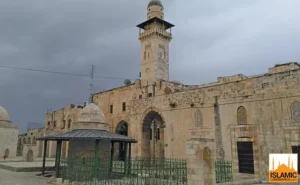
Gate 11 – Bab al Magharibah (The Moroccan Gate)
The Moroccan Gate is actually built on top of another gate from the Herodian period known as Barclay’s Gate. Over the years, the ground level outside this initial gate rose several meters until it was eventually walled up in the 10th century.
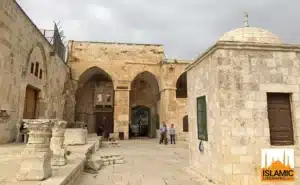
Map of Gates of Masjid Al Aqsa PDF
See the detailed PDF of the gates of Masjid Al Aqsa.
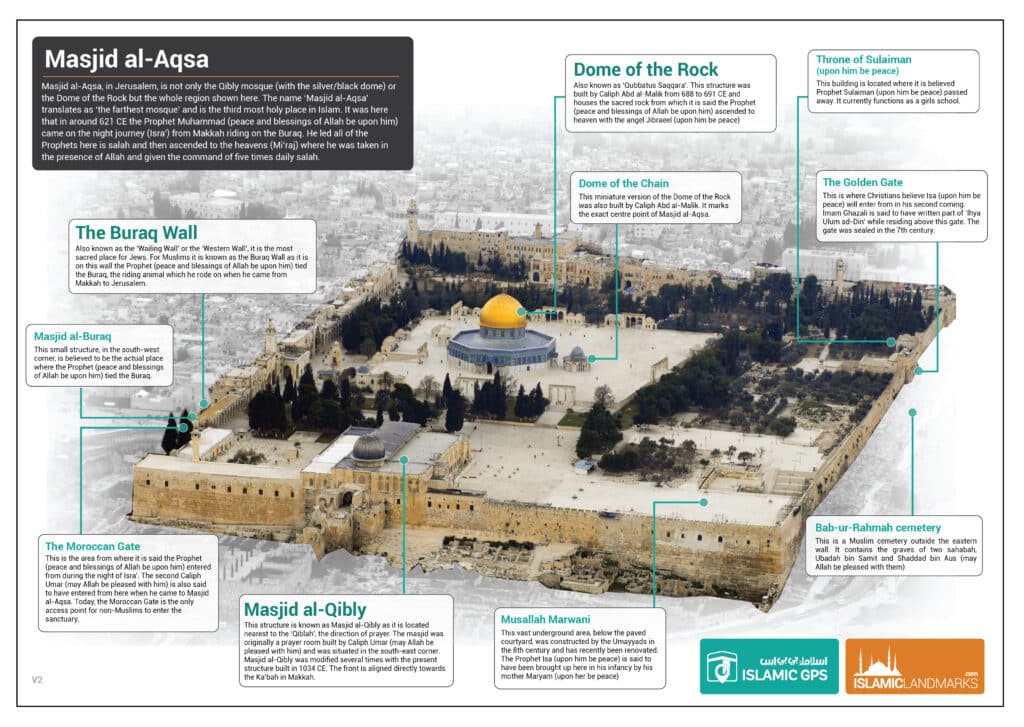
Summary – Gates of Masjid Al Aqsa
As a symbol of deep religious significance and boasting a history that spans centuries, Masjid al-Aqsa and it’s gates stand as a testament to the rich tapestry of Islam.
Beyond its architectural grandeur, Masjid al-Aqsa is distinguished by its myriad of impressive and historically significant gates, each bearing its own story and contributing to the sanctity of the mosque which they grace.
These gates are not merely physical entrances but portals to a spiritual journey and a connection to cultural heritage. The intricate designs and architectural marvels of these gates serve as a visual testament to the craftsmanship of their builders and the enduring legacy of Islam in the region.
Masjid al-Aqsa is not only a place of worship; it is a sacred sanctuary that resonates with the core values of devotion and cultural heritage. Pilgrims and visitors alike are drawn to its hallowed grounds, seeking not just a physical presence but an immersive experience that transcends time and space.
In embracing the diversity of its gates and the spiritual essence they embody, Masjid al-Aqsa continues to stand as a beacon of unity and reverence for Muslims around the world. The mosque is revered by Muslims for its historical and cultural significance.
Through His Names
New course with
Ustadh Shabbir Hassan











